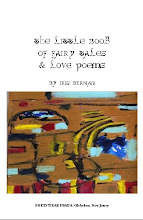
Linda LernerTHE LITTLE BOOK OF FAIRY TALES AND LOVE POEMS By Iris Berman Poets Wear Prada, 533 Bloomfield Street, Hoboken, NJ, 2007, 23pp. $8. CONE INVESTIGATES By Bob Heman Poets Wear Prada, Hoboken, 2007, 12pp. $6.25 | |
| |
The two collections are the latest from Poets Wear Prada Press begun by Roxanne Hoffman in the Fall, '06. Cone's empirical investigations lead him "over the edge of the map" into a world as magic-filled as Iris Berman's fairy tales. The red shoes that lead her "away from/ The beautiful men...Across meadow and dell/ From Mountain to mountain...refuse to stop moving...her mermaid's tears become the salty ocean." Heman's Dr. Cone "melts in the rain;..." the hedonists...view him as a cactus; when he visits "the city of numbers (he) slides inside a seven and disappears for hours." Boundaries between human beings and nature, animate and inanimate objects, don't exist. Dr. Cone thinks he is the reincarnation of an ancient snowstorm ... the wind gets trapped in his beard, and like the red shoes, takes on a life of its own. Berman teaches her lover "To fly on the wisps/ Of smoke burning/ From the tip of (her) cigarette..." In "Cone Dreams" the doctor is led to Barabus by a rooster who "crows just as he reaches the door that he is sure is the right one." Omens are to be taken seriously. A Cinderella "happily every after" story concludes not only Berman's title poem, but also in another in which a couple "stoned out of (their) minds...(make) truth out of lies to reach it." As if by magic, the fairy tale, rooted in the ancient world, and the scientist's investigations into the future, lead to the same place. It is not that the individual is in harmony with nature or in opposition to it, but that both interact, are engaged with each other through an unspoken language. Wishes in dreams come true; curses placed on people are granted, as is Berman's wish that anyone climbing her pear tree get stuck "Mired in muck, caught in mud." In "Cone Awakens" the doctor is stirred by a dream to buy a rooster; the old one no longer crows and there have been no new chicks for a long time. Told there are no more roosters, he turns down an offer of a mechanical alarm, goes into the woods and sacrifices the fattest rabbit he sees to the goddess of the dawn. His old rooster is transformed as if by magic, and "soon little chicks are seen hurrying all around the yard." For both Berman and Heman the surrealistic and fairy tale elements hide the unperceived reality of the world we live in. There is the angry man in "Humpty Dumpty" people "walk on eggshells" around, fearing to send him "over the edge" he eventually falls over; the treatment that cures him ends up killing the person he was, returning a seemingly lobotomized "Strangely quiet...Not the same" man. Rumplestiltskin "an ugly little man...who built an empire...Through bold financial deals" is reminiscent of ceo's who headline the news daily. A satire on how art and indirectly literary reputations are made is explored in "Cone Paints." An artist does a series of white-on-white paintings. The critics who can't differentiate between the shades or the paintings, "applaud him for his courage in filling the grand gallery with five hundred and eighty-two blank white canvases." He never does another painting, and so "his immortality is assured." In "Cone Investigates" there are his clones, the hanger-on assistants we are familiar with, who pretend or imagine they are him. Stylistically, each of these beautifully designed and produced chapbooks bears its own distinctive signature. Berman's poems utilize the short line, a minimum use of punctuation, and are driven by a moderately paced rhythm, sometimes with a refrain, as in "Echo Of Love." "My love goes riding" follows every one or two stanzas twisting around on itself to conclude with "My love won't stop writing." Heman's collection consists of twelve prose poems in as many pages on ivory parchment with a pale green tint. Employing a simple sentence structure like a rope that both anchors and grants him freedom, he lowers himself over the edge,"(leaving) the world of concepts behind...plunging instead into a land of forces and junctions" in which, unseen, he moves as in a dream through an unexplored landscape. As Berman goes riding off the earth with her lover and Cone "pulls magic out a rabbit and stuffs it into his hat," so readers will experience the same when they step into the marvelous worlds fo these two poets. |




































































No comments:
Post a Comment